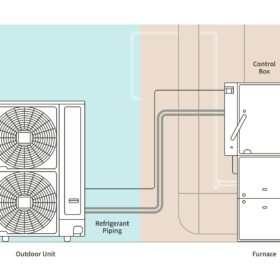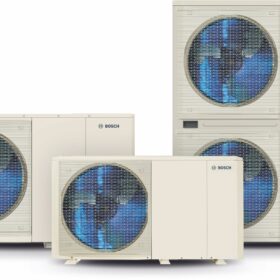Octopus Energy introduces new residential heat pumps
Octopus Energy has developed new residential heat pumps, with plans to initially market a 6 kW version, followed by larger models in the near future. The UK-based company makes the heat pumps at its facility in Craigavon, Northern Ireland.
Research shows heat pumps perform better than fossil fuel heating in mild cold climates
A British research group has aggregated information from seven field studies on heat pumps from around the world and has found air-source devices have an average coefficient of performance (COP) of 2.74 when temperatures are above −10 C. Below that, COP is between 1.5 and 2.
Johnson Controls-Hitachi Air Conditioning unveils residential dual fuel heat pump system
Johnson Controls-Hitachi Air Conditioning has developed a residential dual fuel heat pump system that combines an air source heat pump and a gas furnace. The manufacturer says the furnace is designed to ensure there is no compromise in heating performance, even when temperatures are extremely low.
Worcester Bosch launches new series of high-flow monobloc heat pumps
Worcester Bosch’s new residential heat pumps are available in several versions, with output ranging from 4 kW to 30 KW. It says the new products can be cascaded up to six units.
AI control tech to improve coefficient of performance of air source heat pumps
Scientists from South Korea have developed a heat pump optimization technique that controls the secondary refrigerant flow. The proposed technology offers the advantage of bypassing the need to control the compressor of the heat pump, which is a function that is commonly not available in commercial devices.
PV-driven heat pump system for freshwater production, cooling, hot water
Scientists in India have combined a solar-assisted heat pump with a humidification-dehumidification and vapor compression refrigeration (HDH-VCR) cycle to generate heat and cooling. The system is reportedly able to generate up to 5.5 l per hour (LPH) of fresh water while achieving an ‘enhanced’ coefficient of performance.
Samsung unveils monobloc heat pump for residential applications
Samsung claims its new product is able provide domestic hot water of up to 75 C when the outdoor temperature is between -10 C and 35 C. It relies on an enlarged heat exchanger that the company claims is capable of transferring more heat compared to a conventional outdoor unit.
PV-powered heat pumps with thermal, electrical storage
Italian researchers have looked at the potential of thermal and electrical energy storage to improve self-consumption rates in buildings when coupled with PV-powered heat pumps. They have concluded that such an approach could yield self-consumption rates of more than 80%.
Carrier launches new series of high-temperature heat pumps
Carrier, a US-based heating solutions provider, has introduced a new line of high-temperature heat pumps with capacities ranging from 30 kW to 735 kW, with hydrofluoroolefins as a refrigerant.
Heat pump design to reduce footprint of solar thermal installations
A US-Mexican research team has investigated how linking heat pumps with solar thermal collectors may help reduce the surface needed to deploy the collectors themselves. The scientists found the proposed solution may not only significantly reduce the footprint of solar thermal systems but also provide a lower levelized cost of energy compared to fossil fuels.










